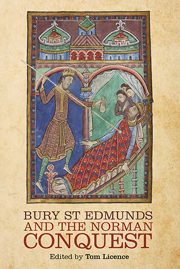Book contents
- Frontmatter
- Contents
- LIST OF ILLUSTRATIONS
- LIST OF MUSIC EXAMPLES
- LIST OF CONTRIBUTORS
- ACKNOWLEDGMENTS
- LIST OF ABBREVIATIONS
- Introduction
- 1 The Abbey and the Norman Conquest an Unusual Case?
- 2 Charters and Influences from Saint-Denis c. 1000–1070
- 3 The Abbey's Armoury of Charters
- 4 The Women of Bury St Edmunds
- 5 Baldwin's Church and the Effects of the Conquest
- 6 New Light on the Life and Work of Herman the Archdeacon
- 7 The Cult of St Edmund
- 8 St Edmund Between Liturgy and Hagiography
- 9 Books and their Use Across the Conquest
- 10 An Eleventh-Century Bury Medical Manuscript
- 11 Medicine at Bury in the Time of Abbot Baldwin
- 12 Medicine After Baldwin: The Evidence of BL, Royal 12. C. xxiv
- Index
4 - The Women of Bury St Edmunds
Published online by Cambridge University Press: 05 August 2014
- Frontmatter
- Contents
- LIST OF ILLUSTRATIONS
- LIST OF MUSIC EXAMPLES
- LIST OF CONTRIBUTORS
- ACKNOWLEDGMENTS
- LIST OF ABBREVIATIONS
- Introduction
- 1 The Abbey and the Norman Conquest an Unusual Case?
- 2 Charters and Influences from Saint-Denis c. 1000–1070
- 3 The Abbey's Armoury of Charters
- 4 The Women of Bury St Edmunds
- 5 Baldwin's Church and the Effects of the Conquest
- 6 New Light on the Life and Work of Herman the Archdeacon
- 7 The Cult of St Edmund
- 8 St Edmund Between Liturgy and Hagiography
- 9 Books and their Use Across the Conquest
- 10 An Eleventh-Century Bury Medical Manuscript
- 11 Medicine at Bury in the Time of Abbot Baldwin
- 12 Medicine After Baldwin: The Evidence of BL, Royal 12. C. xxiv
- Index
Summary
The fourth richest monastery of England in the late eleventh century was a Benedictine monastery for monks – a male institution, one might suppose. Yet, women played an important role in its life. As landholder, Abbot Baldwin was in charge of his landed estate, and the names of his peasant tenants (male and female, predominantly English), have been preserved. Higher up the social ladder among the (Norman) knightly class far less evidence of women has come down to us. Women also lived in the borough that grew up around the monastery. The Domesday survey compiled in 1086 tells of more than 300 dwellings where families were living, though it remains shadowy on the individuals. Washerwomen, for example, are singled out but not their names. My chapter would not be included here if that was the sum total of our information about Bury women. Surprisingly, perhaps, this monks’ community was surrounded by an assortment of single women who lived an informal religious life, attracted no doubt by the presence of St Edmund's body. The Domesday survey records twenty-eight nonnae (nuns or vowesses) and poor persons, while the abbey's rich hagiographical dossier reveals the names and actions of some of them, as does the correspondence of Anselm of Canterbury (1093–1109). Although small communities of religious women at monasteries were a normal feature in western Europe, the scale of female presence at Bury is exceptional.
- Type
- Chapter
- Information
- Bury St Edmunds and the Norman Conquest , pp. 53 - 73Publisher: Boydell & BrewerPrint publication year: 2014

